Marketing Management Case Study: Success of OnePlus Smartphones
VerifiedAdded on 2020/03/04
|19
|4868
|342
Case Study
AI Summary
This case study examines the marketing management strategies of OnePlus, a Chinese smartphone manufacturer. It analyzes the factors contributing to the company's early success, including its "Never Settle" philosophy, focus on tech-savvy customers, social media promotion, user engagement, and unconventional marketing tactics. The study identifies major customer segments, including tech enthusiasts, design enthusiasts, and business professionals, and recommends strategies for positioning and value proposition. It also evaluates the marketing mix (4Ps) and 5Cs of OnePlus, providing recommendations for enhancing customer engagement, investing in R&D, and expanding customer support. The analysis covers the company's strengths, weaknesses, opportunities, and threats (SWOT) and provides insights into how OnePlus can maintain its brand image and competitive advantage in the global smartphone market. The study highlights the importance of understanding customer segments and adapting marketing strategies to changing market dynamics, providing a comprehensive overview of OnePlus's marketing journey and future prospects.
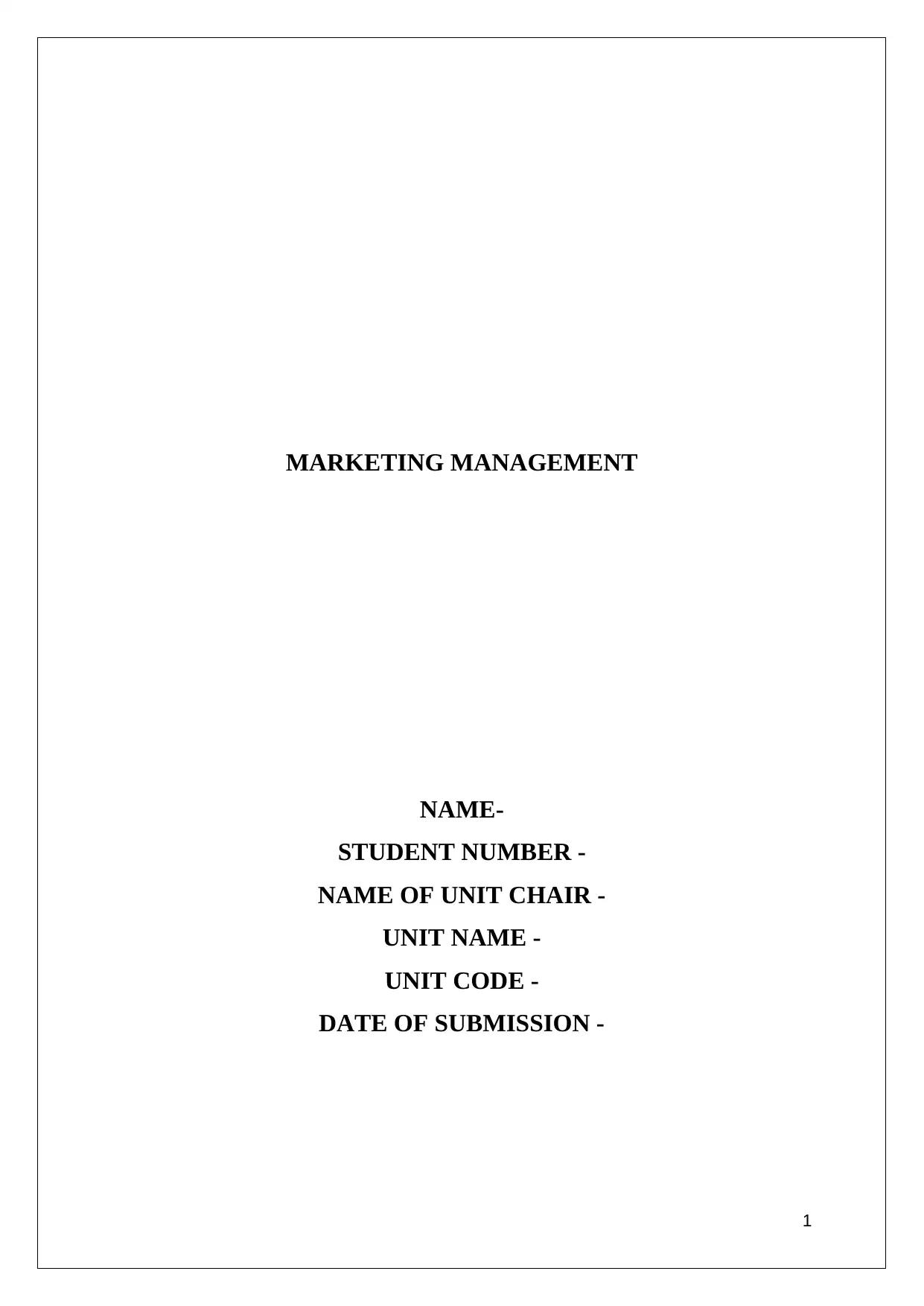
MARKETING MANAGEMENT
NAME-
STUDENT NUMBER -
NAME OF UNIT CHAIR -
UNIT NAME -
UNIT CODE -
DATE OF SUBMISSION -
1
NAME-
STUDENT NUMBER -
NAME OF UNIT CHAIR -
UNIT NAME -
UNIT CODE -
DATE OF SUBMISSION -
1
Paraphrase This Document
Need a fresh take? Get an instant paraphrase of this document with our AI Paraphraser
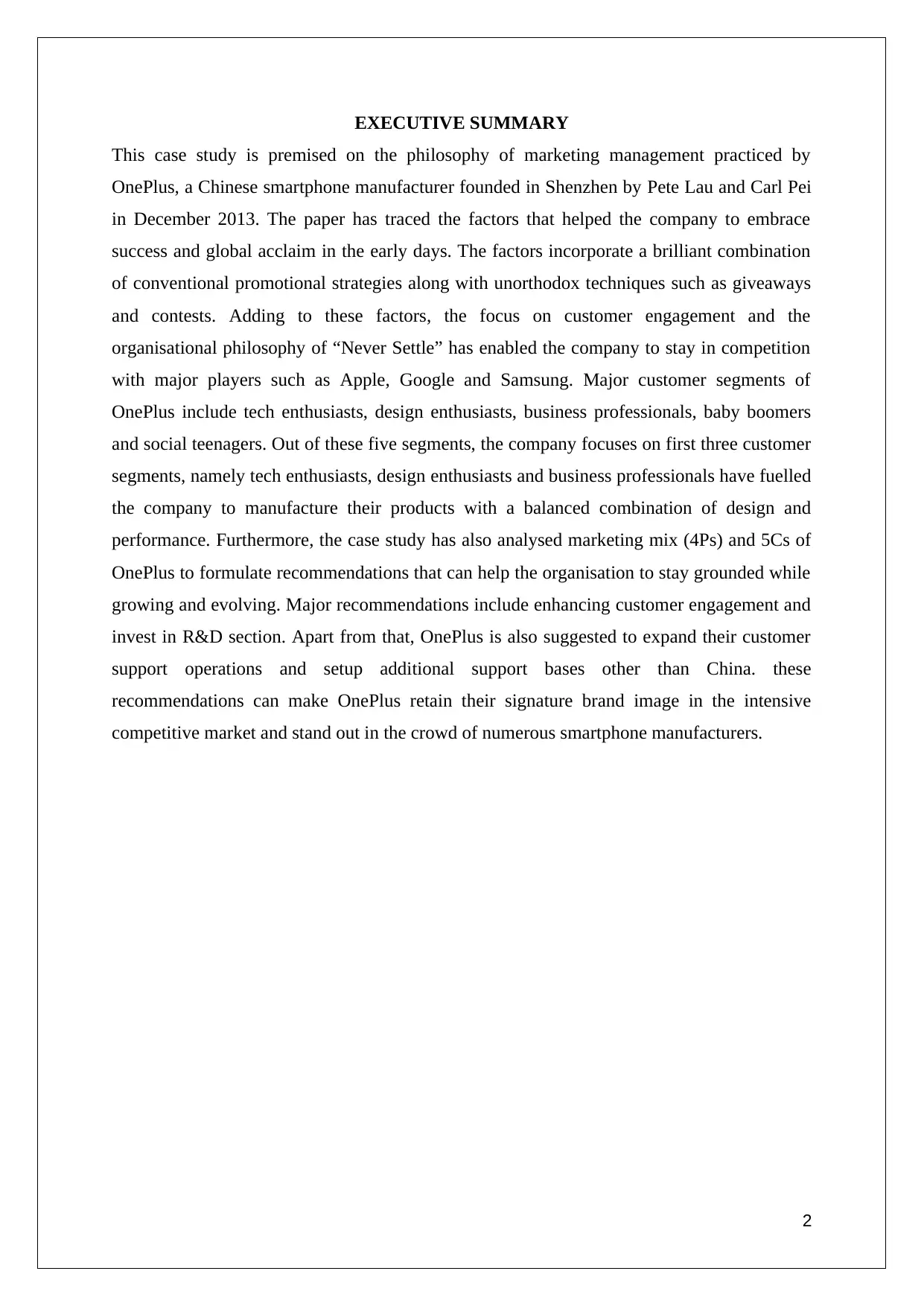
EXECUTIVE SUMMARY
This case study is premised on the philosophy of marketing management practiced by
OnePlus, a Chinese smartphone manufacturer founded in Shenzhen by Pete Lau and Carl Pei
in December 2013. The paper has traced the factors that helped the company to embrace
success and global acclaim in the early days. The factors incorporate a brilliant combination
of conventional promotional strategies along with unorthodox techniques such as giveaways
and contests. Adding to these factors, the focus on customer engagement and the
organisational philosophy of “Never Settle” has enabled the company to stay in competition
with major players such as Apple, Google and Samsung. Major customer segments of
OnePlus include tech enthusiasts, design enthusiasts, business professionals, baby boomers
and social teenagers. Out of these five segments, the company focuses on first three customer
segments, namely tech enthusiasts, design enthusiasts and business professionals have fuelled
the company to manufacture their products with a balanced combination of design and
performance. Furthermore, the case study has also analysed marketing mix (4Ps) and 5Cs of
OnePlus to formulate recommendations that can help the organisation to stay grounded while
growing and evolving. Major recommendations include enhancing customer engagement and
invest in R&D section. Apart from that, OnePlus is also suggested to expand their customer
support operations and setup additional support bases other than China. these
recommendations can make OnePlus retain their signature brand image in the intensive
competitive market and stand out in the crowd of numerous smartphone manufacturers.
2
This case study is premised on the philosophy of marketing management practiced by
OnePlus, a Chinese smartphone manufacturer founded in Shenzhen by Pete Lau and Carl Pei
in December 2013. The paper has traced the factors that helped the company to embrace
success and global acclaim in the early days. The factors incorporate a brilliant combination
of conventional promotional strategies along with unorthodox techniques such as giveaways
and contests. Adding to these factors, the focus on customer engagement and the
organisational philosophy of “Never Settle” has enabled the company to stay in competition
with major players such as Apple, Google and Samsung. Major customer segments of
OnePlus include tech enthusiasts, design enthusiasts, business professionals, baby boomers
and social teenagers. Out of these five segments, the company focuses on first three customer
segments, namely tech enthusiasts, design enthusiasts and business professionals have fuelled
the company to manufacture their products with a balanced combination of design and
performance. Furthermore, the case study has also analysed marketing mix (4Ps) and 5Cs of
OnePlus to formulate recommendations that can help the organisation to stay grounded while
growing and evolving. Major recommendations include enhancing customer engagement and
invest in R&D section. Apart from that, OnePlus is also suggested to expand their customer
support operations and setup additional support bases other than China. these
recommendations can make OnePlus retain their signature brand image in the intensive
competitive market and stand out in the crowd of numerous smartphone manufacturers.
2
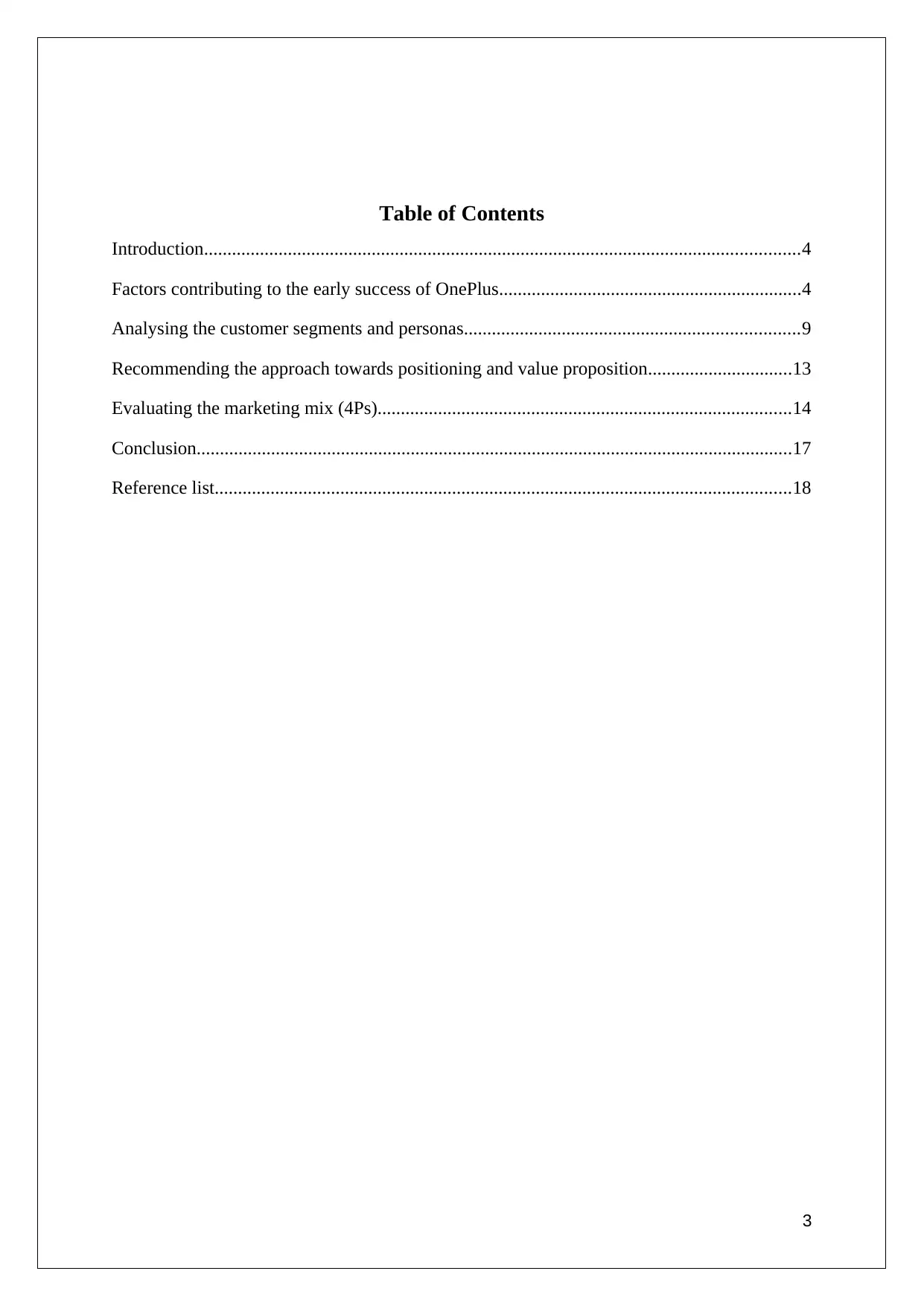
Table of Contents
Introduction................................................................................................................................4
Factors contributing to the early success of OnePlus.................................................................4
Analysing the customer segments and personas........................................................................9
Recommending the approach towards positioning and value proposition...............................13
Evaluating the marketing mix (4Ps).........................................................................................14
Conclusion................................................................................................................................17
Reference list............................................................................................................................18
3
Introduction................................................................................................................................4
Factors contributing to the early success of OnePlus.................................................................4
Analysing the customer segments and personas........................................................................9
Recommending the approach towards positioning and value proposition...............................13
Evaluating the marketing mix (4Ps).........................................................................................14
Conclusion................................................................................................................................17
Reference list............................................................................................................................18
3
⊘ This is a preview!⊘
Do you want full access?
Subscribe today to unlock all pages.

Trusted by 1+ million students worldwide
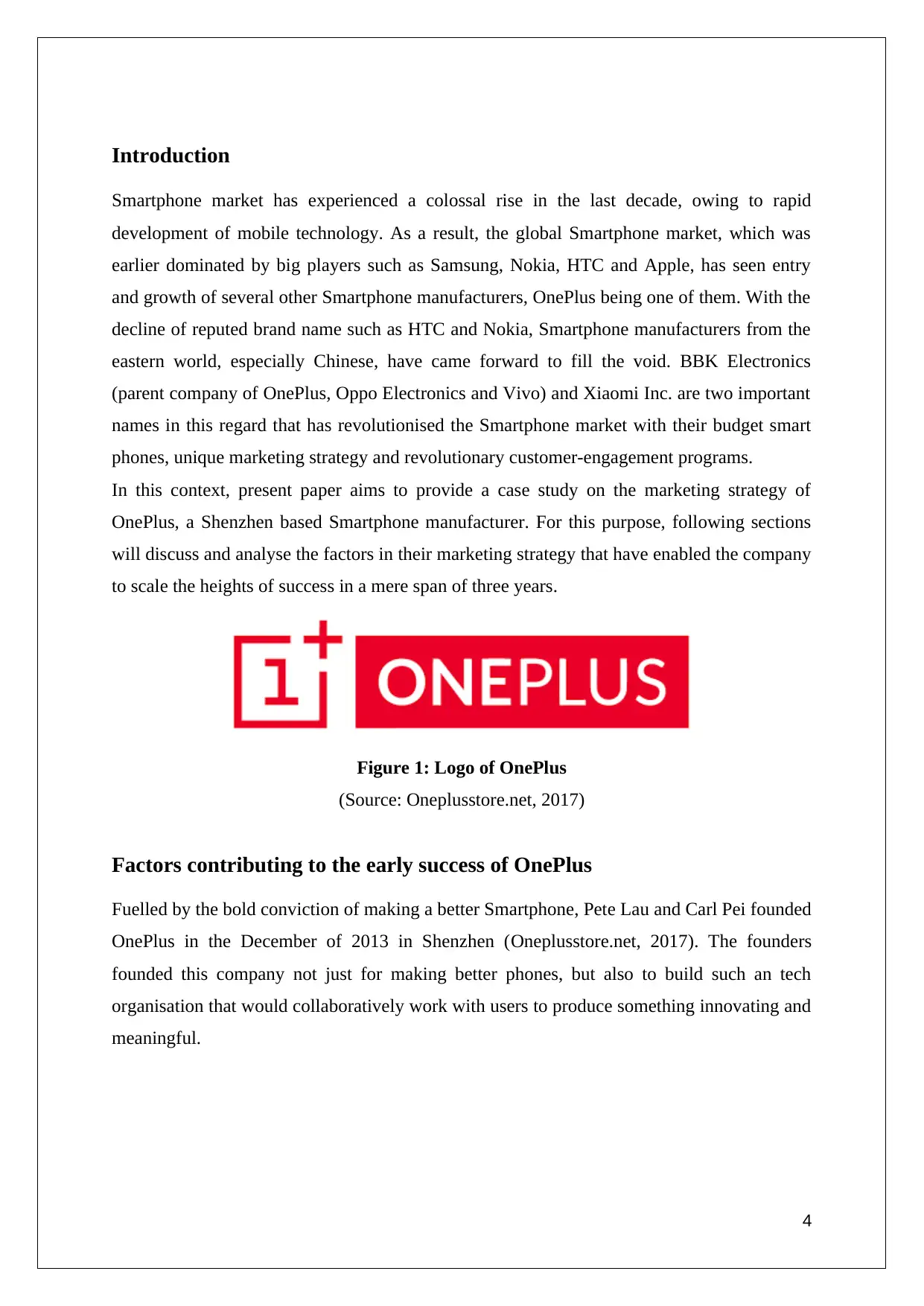
Introduction
Smartphone market has experienced a colossal rise in the last decade, owing to rapid
development of mobile technology. As a result, the global Smartphone market, which was
earlier dominated by big players such as Samsung, Nokia, HTC and Apple, has seen entry
and growth of several other Smartphone manufacturers, OnePlus being one of them. With the
decline of reputed brand name such as HTC and Nokia, Smartphone manufacturers from the
eastern world, especially Chinese, have came forward to fill the void. BBK Electronics
(parent company of OnePlus, Oppo Electronics and Vivo) and Xiaomi Inc. are two important
names in this regard that has revolutionised the Smartphone market with their budget smart
phones, unique marketing strategy and revolutionary customer-engagement programs.
In this context, present paper aims to provide a case study on the marketing strategy of
OnePlus, a Shenzhen based Smartphone manufacturer. For this purpose, following sections
will discuss and analyse the factors in their marketing strategy that have enabled the company
to scale the heights of success in a mere span of three years.
Figure 1: Logo of OnePlus
(Source: Oneplusstore.net, 2017)
Factors contributing to the early success of OnePlus
Fuelled by the bold conviction of making a better Smartphone, Pete Lau and Carl Pei founded
OnePlus in the December of 2013 in Shenzhen (Oneplusstore.net, 2017). The founders
founded this company not just for making better phones, but also to build such an tech
organisation that would collaboratively work with users to produce something innovating and
meaningful.
4
Smartphone market has experienced a colossal rise in the last decade, owing to rapid
development of mobile technology. As a result, the global Smartphone market, which was
earlier dominated by big players such as Samsung, Nokia, HTC and Apple, has seen entry
and growth of several other Smartphone manufacturers, OnePlus being one of them. With the
decline of reputed brand name such as HTC and Nokia, Smartphone manufacturers from the
eastern world, especially Chinese, have came forward to fill the void. BBK Electronics
(parent company of OnePlus, Oppo Electronics and Vivo) and Xiaomi Inc. are two important
names in this regard that has revolutionised the Smartphone market with their budget smart
phones, unique marketing strategy and revolutionary customer-engagement programs.
In this context, present paper aims to provide a case study on the marketing strategy of
OnePlus, a Shenzhen based Smartphone manufacturer. For this purpose, following sections
will discuss and analyse the factors in their marketing strategy that have enabled the company
to scale the heights of success in a mere span of three years.
Figure 1: Logo of OnePlus
(Source: Oneplusstore.net, 2017)
Factors contributing to the early success of OnePlus
Fuelled by the bold conviction of making a better Smartphone, Pete Lau and Carl Pei founded
OnePlus in the December of 2013 in Shenzhen (Oneplusstore.net, 2017). The founders
founded this company not just for making better phones, but also to build such an tech
organisation that would collaboratively work with users to produce something innovating and
meaningful.
4
Paraphrase This Document
Need a fresh take? Get an instant paraphrase of this document with our AI Paraphraser
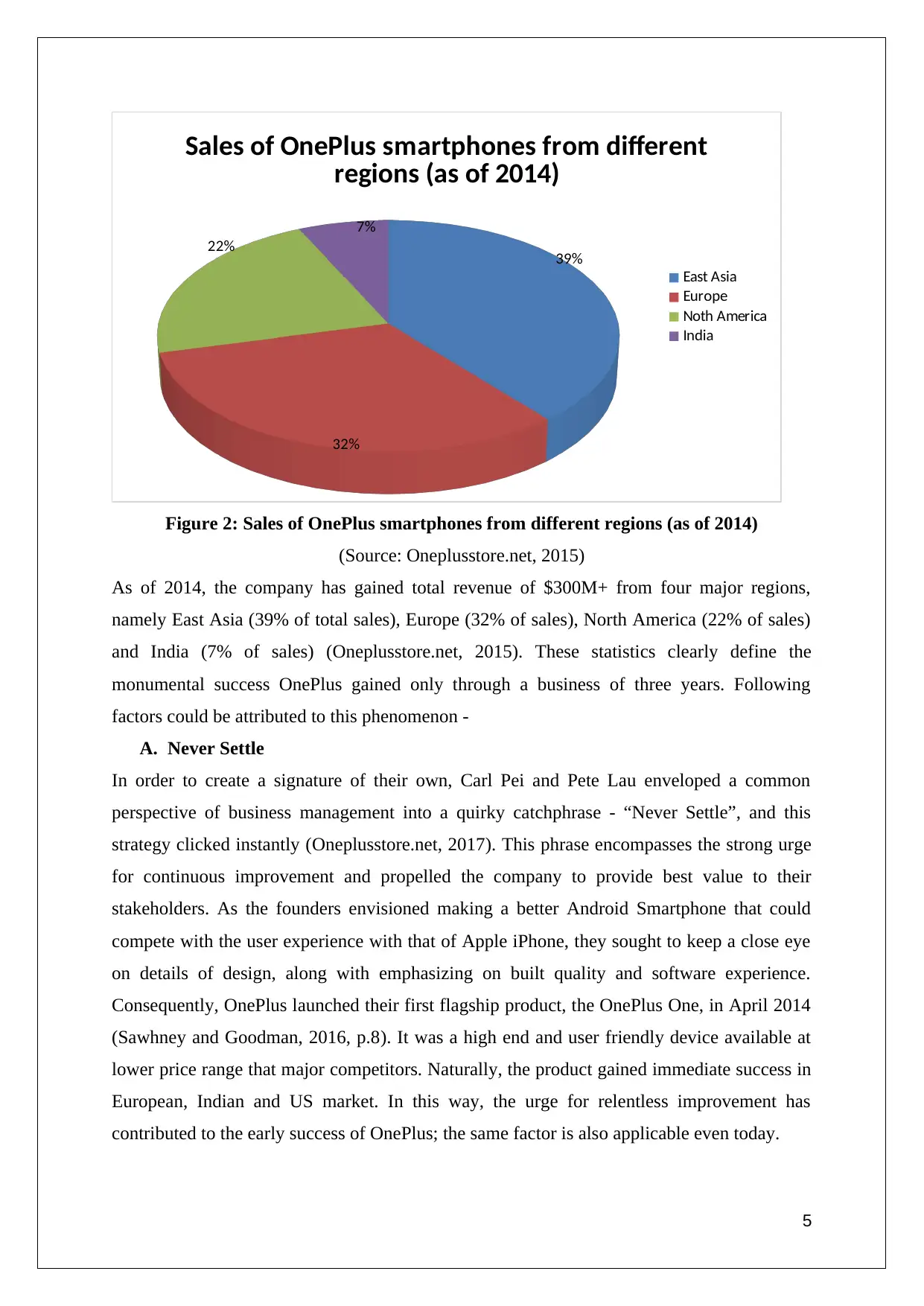
39%
32%
22%
7%
Sales of OnePlus smartphones from different
regions (as of 2014)
East Asia
Europe
Noth America
India
Figure 2: Sales of OnePlus smartphones from different regions (as of 2014)
(Source: Oneplusstore.net, 2015)
As of 2014, the company has gained total revenue of $300M+ from four major regions,
namely East Asia (39% of total sales), Europe (32% of sales), North America (22% of sales)
and India (7% of sales) (Oneplusstore.net, 2015). These statistics clearly define the
monumental success OnePlus gained only through a business of three years. Following
factors could be attributed to this phenomenon -
A. Never Settle
In order to create a signature of their own, Carl Pei and Pete Lau enveloped a common
perspective of business management into a quirky catchphrase - “Never Settle”, and this
strategy clicked instantly (Oneplusstore.net, 2017). This phrase encompasses the strong urge
for continuous improvement and propelled the company to provide best value to their
stakeholders. As the founders envisioned making a better Android Smartphone that could
compete with the user experience with that of Apple iPhone, they sought to keep a close eye
on details of design, along with emphasizing on built quality and software experience.
Consequently, OnePlus launched their first flagship product, the OnePlus One, in April 2014
(Sawhney and Goodman, 2016, p.8). It was a high end and user friendly device available at
lower price range that major competitors. Naturally, the product gained immediate success in
European, Indian and US market. In this way, the urge for relentless improvement has
contributed to the early success of OnePlus; the same factor is also applicable even today.
5
32%
22%
7%
Sales of OnePlus smartphones from different
regions (as of 2014)
East Asia
Europe
Noth America
India
Figure 2: Sales of OnePlus smartphones from different regions (as of 2014)
(Source: Oneplusstore.net, 2015)
As of 2014, the company has gained total revenue of $300M+ from four major regions,
namely East Asia (39% of total sales), Europe (32% of sales), North America (22% of sales)
and India (7% of sales) (Oneplusstore.net, 2015). These statistics clearly define the
monumental success OnePlus gained only through a business of three years. Following
factors could be attributed to this phenomenon -
A. Never Settle
In order to create a signature of their own, Carl Pei and Pete Lau enveloped a common
perspective of business management into a quirky catchphrase - “Never Settle”, and this
strategy clicked instantly (Oneplusstore.net, 2017). This phrase encompasses the strong urge
for continuous improvement and propelled the company to provide best value to their
stakeholders. As the founders envisioned making a better Android Smartphone that could
compete with the user experience with that of Apple iPhone, they sought to keep a close eye
on details of design, along with emphasizing on built quality and software experience.
Consequently, OnePlus launched their first flagship product, the OnePlus One, in April 2014
(Sawhney and Goodman, 2016, p.8). It was a high end and user friendly device available at
lower price range that major competitors. Naturally, the product gained immediate success in
European, Indian and US market. In this way, the urge for relentless improvement has
contributed to the early success of OnePlus; the same factor is also applicable even today.
5
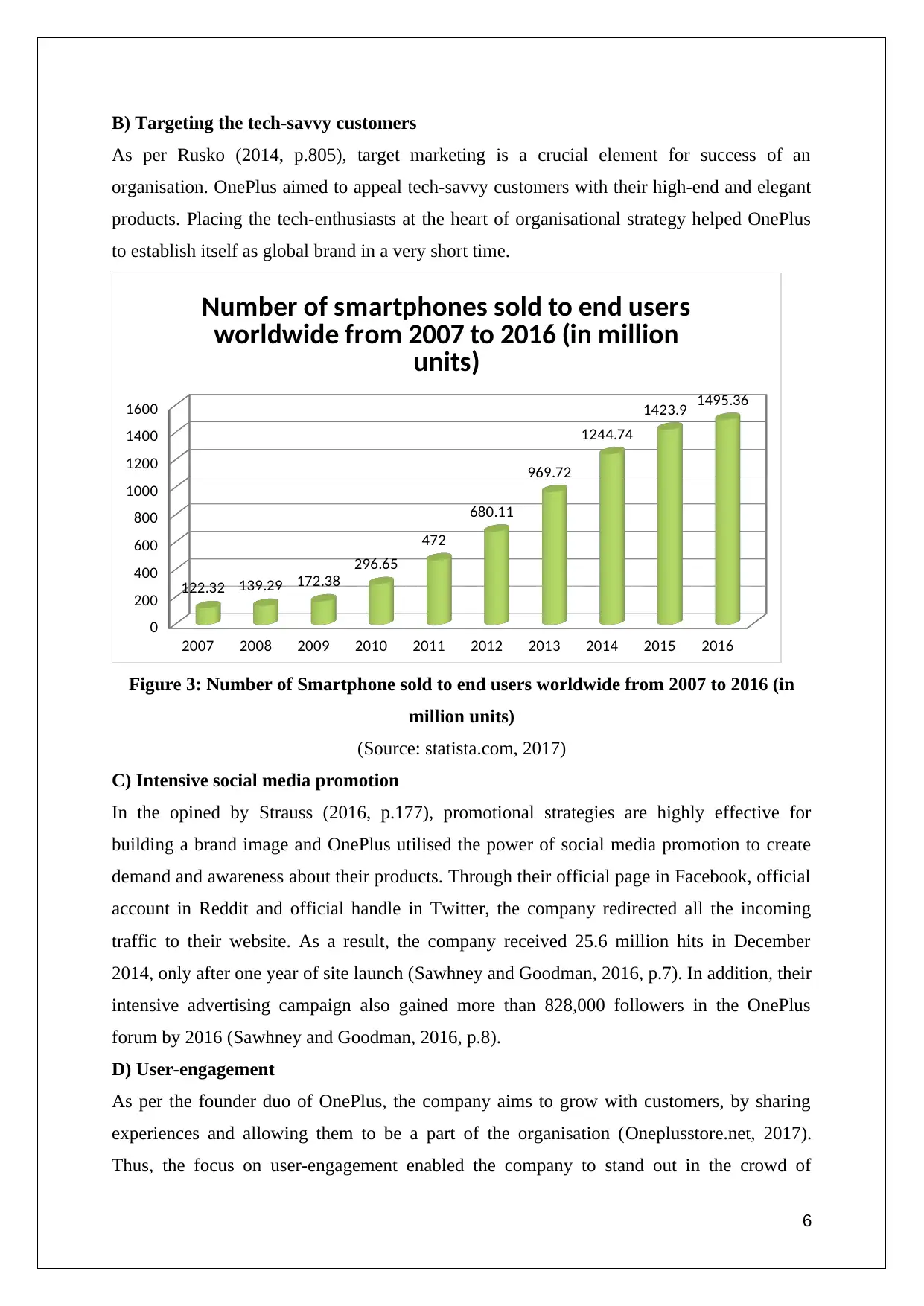
B) Targeting the tech-savvy customers
As per Rusko (2014, p.805), target marketing is a crucial element for success of an
organisation. OnePlus aimed to appeal tech-savvy customers with their high-end and elegant
products. Placing the tech-enthusiasts at the heart of organisational strategy helped OnePlus
to establish itself as global brand in a very short time.
2007 2008 2009 2010 2011 2012 2013 2014 2015 2016
0
200
400
600
800
1000
1200
1400
1600
122.32 139.29 172.38
296.65
472
680.11
969.72
1244.74
1423.9 1495.36
Number of smartphones sold to end users
worldwide from 2007 to 2016 (in million
units)
Figure 3: Number of Smartphone sold to end users worldwide from 2007 to 2016 (in
million units)
(Source: statista.com, 2017)
C) Intensive social media promotion
In the opined by Strauss (2016, p.177), promotional strategies are highly effective for
building a brand image and OnePlus utilised the power of social media promotion to create
demand and awareness about their products. Through their official page in Facebook, official
account in Reddit and official handle in Twitter, the company redirected all the incoming
traffic to their website. As a result, the company received 25.6 million hits in December
2014, only after one year of site launch (Sawhney and Goodman, 2016, p.7). In addition, their
intensive advertising campaign also gained more than 828,000 followers in the OnePlus
forum by 2016 (Sawhney and Goodman, 2016, p.8).
D) User-engagement
As per the founder duo of OnePlus, the company aims to grow with customers, by sharing
experiences and allowing them to be a part of the organisation (Oneplusstore.net, 2017).
Thus, the focus on user-engagement enabled the company to stand out in the crowd of
6
As per Rusko (2014, p.805), target marketing is a crucial element for success of an
organisation. OnePlus aimed to appeal tech-savvy customers with their high-end and elegant
products. Placing the tech-enthusiasts at the heart of organisational strategy helped OnePlus
to establish itself as global brand in a very short time.
2007 2008 2009 2010 2011 2012 2013 2014 2015 2016
0
200
400
600
800
1000
1200
1400
1600
122.32 139.29 172.38
296.65
472
680.11
969.72
1244.74
1423.9 1495.36
Number of smartphones sold to end users
worldwide from 2007 to 2016 (in million
units)
Figure 3: Number of Smartphone sold to end users worldwide from 2007 to 2016 (in
million units)
(Source: statista.com, 2017)
C) Intensive social media promotion
In the opined by Strauss (2016, p.177), promotional strategies are highly effective for
building a brand image and OnePlus utilised the power of social media promotion to create
demand and awareness about their products. Through their official page in Facebook, official
account in Reddit and official handle in Twitter, the company redirected all the incoming
traffic to their website. As a result, the company received 25.6 million hits in December
2014, only after one year of site launch (Sawhney and Goodman, 2016, p.7). In addition, their
intensive advertising campaign also gained more than 828,000 followers in the OnePlus
forum by 2016 (Sawhney and Goodman, 2016, p.8).
D) User-engagement
As per the founder duo of OnePlus, the company aims to grow with customers, by sharing
experiences and allowing them to be a part of the organisation (Oneplusstore.net, 2017).
Thus, the focus on user-engagement enabled the company to stand out in the crowd of
6
⊘ This is a preview!⊘
Do you want full access?
Subscribe today to unlock all pages.

Trusted by 1+ million students worldwide
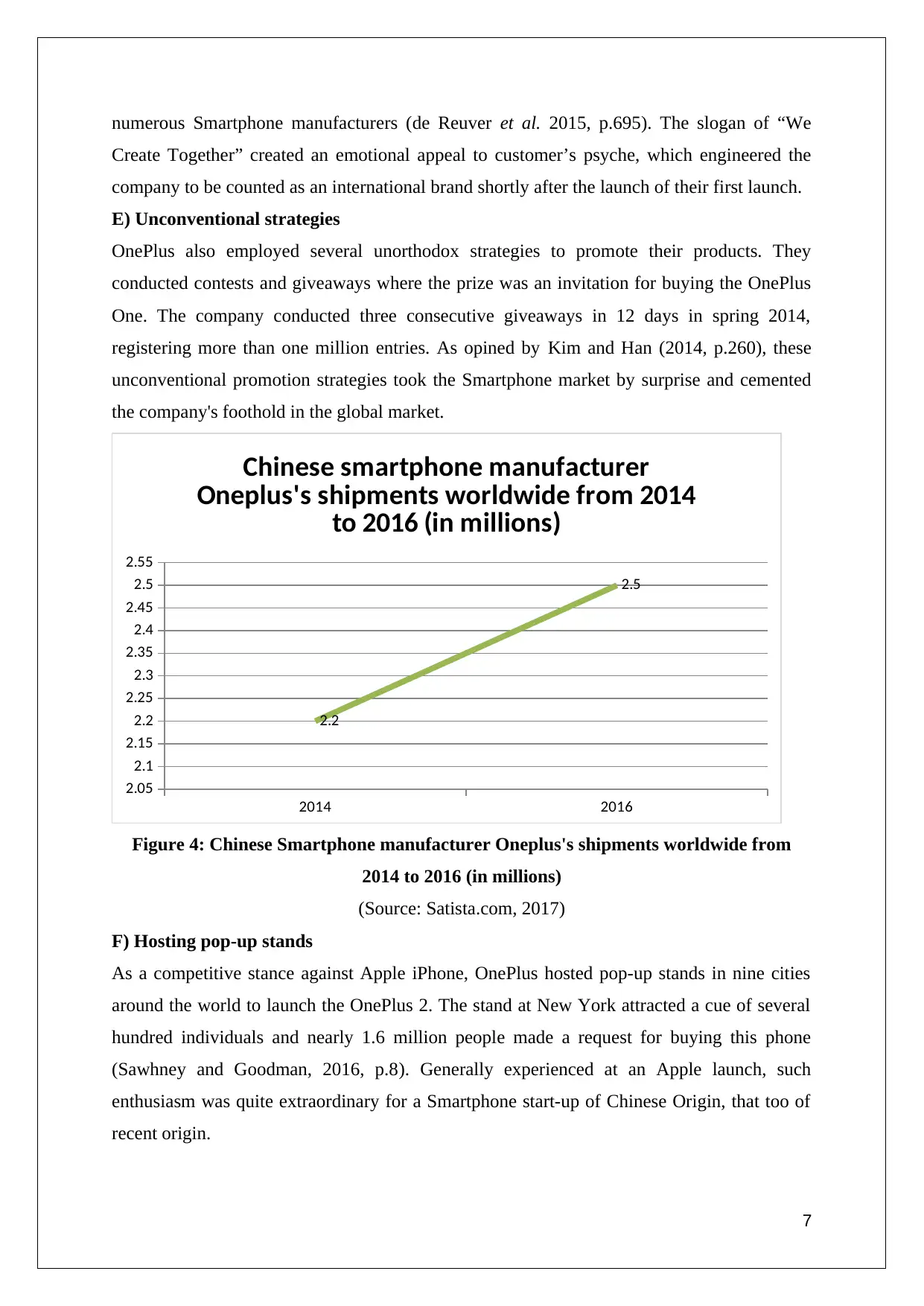
numerous Smartphone manufacturers (de Reuver et al. 2015, p.695). The slogan of “We
Create Together” created an emotional appeal to customer’s psyche, which engineered the
company to be counted as an international brand shortly after the launch of their first launch.
E) Unconventional strategies
OnePlus also employed several unorthodox strategies to promote their products. They
conducted contests and giveaways where the prize was an invitation for buying the OnePlus
One. The company conducted three consecutive giveaways in 12 days in spring 2014,
registering more than one million entries. As opined by Kim and Han (2014, p.260), these
unconventional promotion strategies took the Smartphone market by surprise and cemented
the company's foothold in the global market.
2014 2016
2.05
2.1
2.15
2.2
2.25
2.3
2.35
2.4
2.45
2.5
2.55
2.2
2.5
Chinese smartphone manufacturer
Oneplus's shipments worldwide from 2014
to 2016 (in millions)
Figure 4: Chinese Smartphone manufacturer Oneplus's shipments worldwide from
2014 to 2016 (in millions)
(Source: Satista.com, 2017)
F) Hosting pop-up stands
As a competitive stance against Apple iPhone, OnePlus hosted pop-up stands in nine cities
around the world to launch the OnePlus 2. The stand at New York attracted a cue of several
hundred individuals and nearly 1.6 million people made a request for buying this phone
(Sawhney and Goodman, 2016, p.8). Generally experienced at an Apple launch, such
enthusiasm was quite extraordinary for a Smartphone start-up of Chinese Origin, that too of
recent origin.
7
Create Together” created an emotional appeal to customer’s psyche, which engineered the
company to be counted as an international brand shortly after the launch of their first launch.
E) Unconventional strategies
OnePlus also employed several unorthodox strategies to promote their products. They
conducted contests and giveaways where the prize was an invitation for buying the OnePlus
One. The company conducted three consecutive giveaways in 12 days in spring 2014,
registering more than one million entries. As opined by Kim and Han (2014, p.260), these
unconventional promotion strategies took the Smartphone market by surprise and cemented
the company's foothold in the global market.
2014 2016
2.05
2.1
2.15
2.2
2.25
2.3
2.35
2.4
2.45
2.5
2.55
2.2
2.5
Chinese smartphone manufacturer
Oneplus's shipments worldwide from 2014
to 2016 (in millions)
Figure 4: Chinese Smartphone manufacturer Oneplus's shipments worldwide from
2014 to 2016 (in millions)
(Source: Satista.com, 2017)
F) Hosting pop-up stands
As a competitive stance against Apple iPhone, OnePlus hosted pop-up stands in nine cities
around the world to launch the OnePlus 2. The stand at New York attracted a cue of several
hundred individuals and nearly 1.6 million people made a request for buying this phone
(Sawhney and Goodman, 2016, p.8). Generally experienced at an Apple launch, such
enthusiasm was quite extraordinary for a Smartphone start-up of Chinese Origin, that too of
recent origin.
7
Paraphrase This Document
Need a fresh take? Get an instant paraphrase of this document with our AI Paraphraser
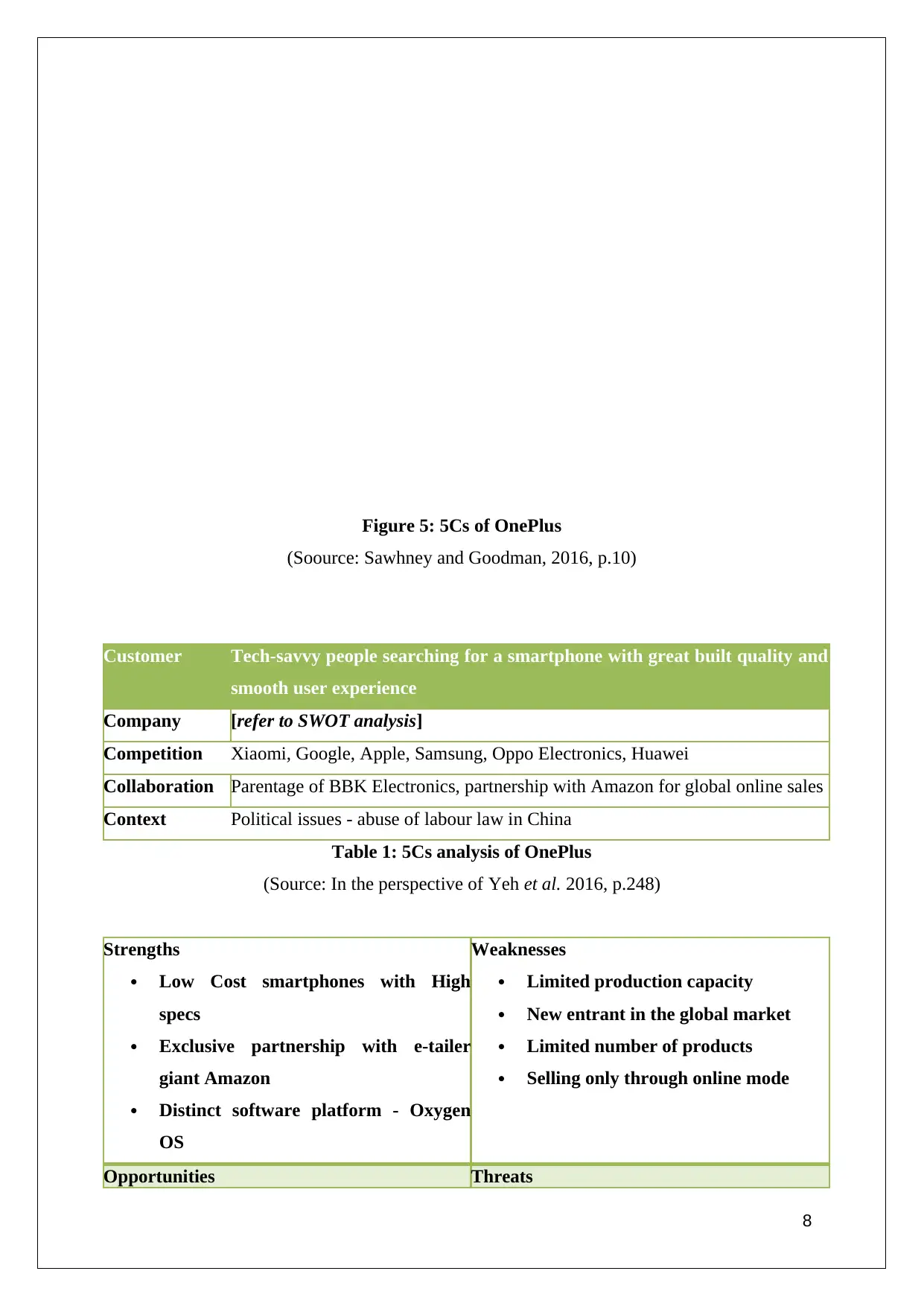
Figure 5: 5Cs of OnePlus
(Soource: Sawhney and Goodman, 2016, p.10)
Customer Tech-savvy people searching for a smartphone with great built quality and
smooth user experience
Company [refer to SWOT analysis]
Competition Xiaomi, Google, Apple, Samsung, Oppo Electronics, Huawei
Collaboration Parentage of BBK Electronics, partnership with Amazon for global online sales
Context Political issues - abuse of labour law in China
Table 1: 5Cs analysis of OnePlus
(Source: In the perspective of Yeh et al. 2016, p.248)
Strengths
Low Cost smartphones with High
specs
Exclusive partnership with e-tailer
giant Amazon
Distinct software platform - Oxygen
OS
Weaknesses
Limited production capacity
New entrant in the global market
Limited number of products
Selling only through online mode
Opportunities Threats
8
(Soource: Sawhney and Goodman, 2016, p.10)
Customer Tech-savvy people searching for a smartphone with great built quality and
smooth user experience
Company [refer to SWOT analysis]
Competition Xiaomi, Google, Apple, Samsung, Oppo Electronics, Huawei
Collaboration Parentage of BBK Electronics, partnership with Amazon for global online sales
Context Political issues - abuse of labour law in China
Table 1: 5Cs analysis of OnePlus
(Source: In the perspective of Yeh et al. 2016, p.248)
Strengths
Low Cost smartphones with High
specs
Exclusive partnership with e-tailer
giant Amazon
Distinct software platform - Oxygen
OS
Weaknesses
Limited production capacity
New entrant in the global market
Limited number of products
Selling only through online mode
Opportunities Threats
8
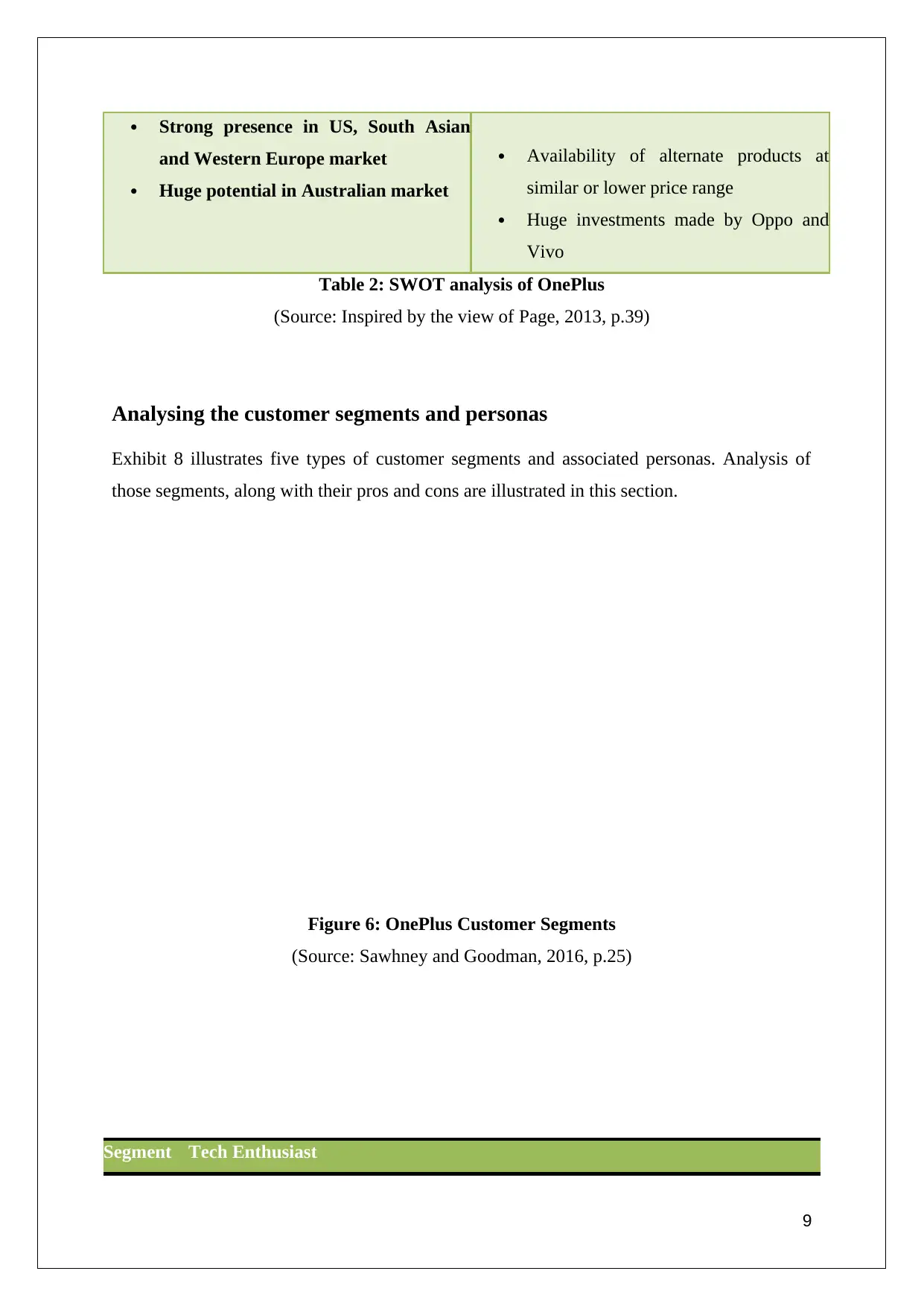
Strong presence in US, South Asian
and Western Europe market
Huge potential in Australian market
Availability of alternate products at
similar or lower price range
Huge investments made by Oppo and
Vivo
Table 2: SWOT analysis of OnePlus
(Source: Inspired by the view of Page, 2013, p.39)
Analysing the customer segments and personas
Exhibit 8 illustrates five types of customer segments and associated personas. Analysis of
those segments, along with their pros and cons are illustrated in this section.
Figure 6: OnePlus Customer Segments
(Source: Sawhney and Goodman, 2016, p.25)
Segment Tech Enthusiast
9
and Western Europe market
Huge potential in Australian market
Availability of alternate products at
similar or lower price range
Huge investments made by Oppo and
Vivo
Table 2: SWOT analysis of OnePlus
(Source: Inspired by the view of Page, 2013, p.39)
Analysing the customer segments and personas
Exhibit 8 illustrates five types of customer segments and associated personas. Analysis of
those segments, along with their pros and cons are illustrated in this section.
Figure 6: OnePlus Customer Segments
(Source: Sawhney and Goodman, 2016, p.25)
Segment Tech Enthusiast
9
⊘ This is a preview!⊘
Do you want full access?
Subscribe today to unlock all pages.

Trusted by 1+ million students worldwide
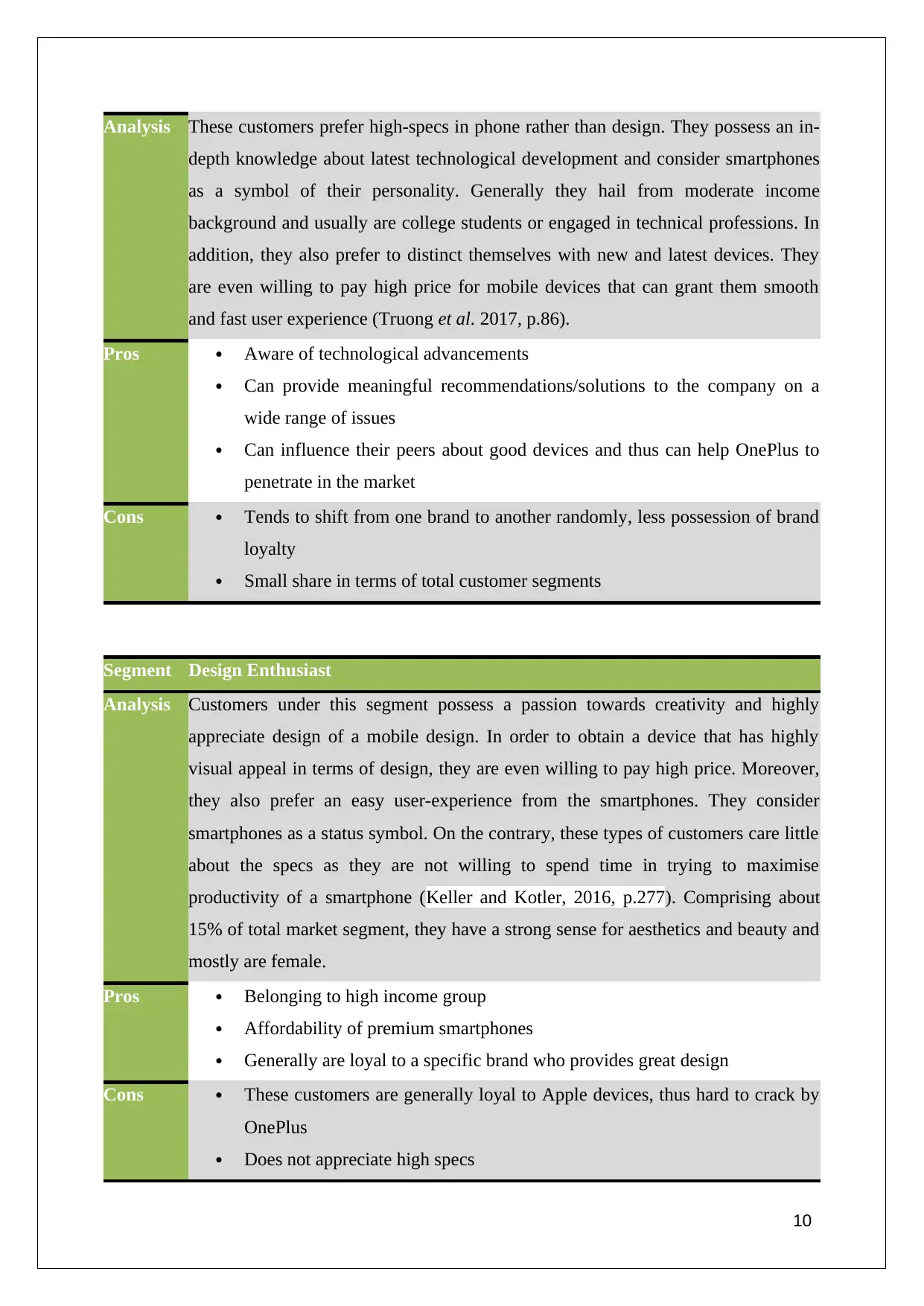
Analysis These customers prefer high-specs in phone rather than design. They possess an in-
depth knowledge about latest technological development and consider smartphones
as a symbol of their personality. Generally they hail from moderate income
background and usually are college students or engaged in technical professions. In
addition, they also prefer to distinct themselves with new and latest devices. They
are even willing to pay high price for mobile devices that can grant them smooth
and fast user experience (Truong et al. 2017, p.86).
Pros Aware of technological advancements
Can provide meaningful recommendations/solutions to the company on a
wide range of issues
Can influence their peers about good devices and thus can help OnePlus to
penetrate in the market
Cons Tends to shift from one brand to another randomly, less possession of brand
loyalty
Small share in terms of total customer segments
Segment Design Enthusiast
Analysis Customers under this segment possess a passion towards creativity and highly
appreciate design of a mobile design. In order to obtain a device that has highly
visual appeal in terms of design, they are even willing to pay high price. Moreover,
they also prefer an easy user-experience from the smartphones. They consider
smartphones as a status symbol. On the contrary, these types of customers care little
about the specs as they are not willing to spend time in trying to maximise
productivity of a smartphone (Keller and Kotler, 2016, p.277). Comprising about
15% of total market segment, they have a strong sense for aesthetics and beauty and
mostly are female.
Pros Belonging to high income group
Affordability of premium smartphones
Generally are loyal to a specific brand who provides great design
Cons These customers are generally loyal to Apple devices, thus hard to crack by
OnePlus
Does not appreciate high specs
10
depth knowledge about latest technological development and consider smartphones
as a symbol of their personality. Generally they hail from moderate income
background and usually are college students or engaged in technical professions. In
addition, they also prefer to distinct themselves with new and latest devices. They
are even willing to pay high price for mobile devices that can grant them smooth
and fast user experience (Truong et al. 2017, p.86).
Pros Aware of technological advancements
Can provide meaningful recommendations/solutions to the company on a
wide range of issues
Can influence their peers about good devices and thus can help OnePlus to
penetrate in the market
Cons Tends to shift from one brand to another randomly, less possession of brand
loyalty
Small share in terms of total customer segments
Segment Design Enthusiast
Analysis Customers under this segment possess a passion towards creativity and highly
appreciate design of a mobile design. In order to obtain a device that has highly
visual appeal in terms of design, they are even willing to pay high price. Moreover,
they also prefer an easy user-experience from the smartphones. They consider
smartphones as a status symbol. On the contrary, these types of customers care little
about the specs as they are not willing to spend time in trying to maximise
productivity of a smartphone (Keller and Kotler, 2016, p.277). Comprising about
15% of total market segment, they have a strong sense for aesthetics and beauty and
mostly are female.
Pros Belonging to high income group
Affordability of premium smartphones
Generally are loyal to a specific brand who provides great design
Cons These customers are generally loyal to Apple devices, thus hard to crack by
OnePlus
Does not appreciate high specs
10
Paraphrase This Document
Need a fresh take? Get an instant paraphrase of this document with our AI Paraphraser
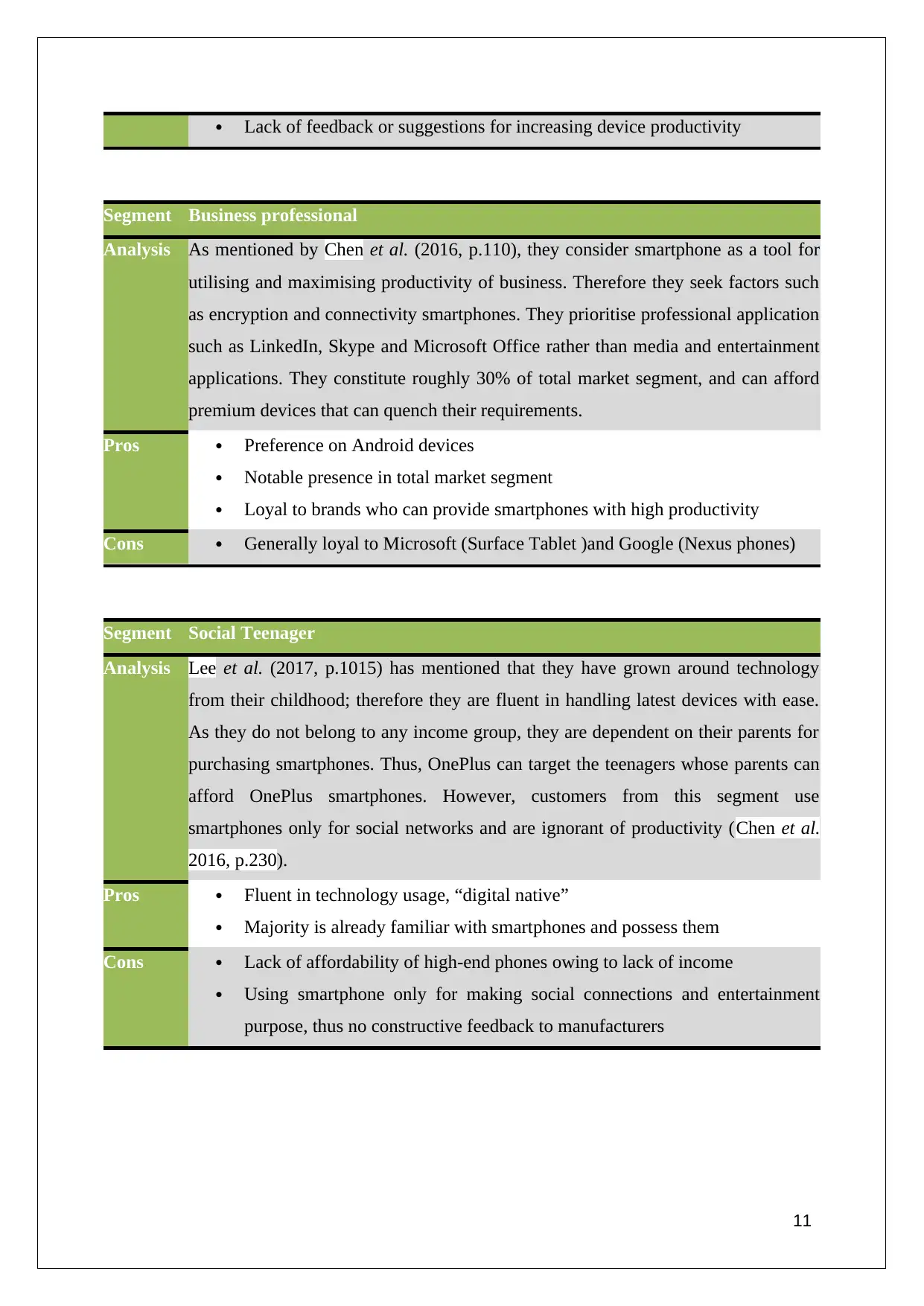
Lack of feedback or suggestions for increasing device productivity
Segment Business professional
Analysis As mentioned by Chen et al. (2016, p.110), they consider smartphone as a tool for
utilising and maximising productivity of business. Therefore they seek factors such
as encryption and connectivity smartphones. They prioritise professional application
such as LinkedIn, Skype and Microsoft Office rather than media and entertainment
applications. They constitute roughly 30% of total market segment, and can afford
premium devices that can quench their requirements.
Pros Preference on Android devices
Notable presence in total market segment
Loyal to brands who can provide smartphones with high productivity
Cons Generally loyal to Microsoft (Surface Tablet )and Google (Nexus phones)
Segment Social Teenager
Analysis Lee et al. (2017, p.1015) has mentioned that they have grown around technology
from their childhood; therefore they are fluent in handling latest devices with ease.
As they do not belong to any income group, they are dependent on their parents for
purchasing smartphones. Thus, OnePlus can target the teenagers whose parents can
afford OnePlus smartphones. However, customers from this segment use
smartphones only for social networks and are ignorant of productivity (Chen et al.
2016, p.230).
Pros Fluent in technology usage, “digital native”
Majority is already familiar with smartphones and possess them
Cons Lack of affordability of high-end phones owing to lack of income
Using smartphone only for making social connections and entertainment
purpose, thus no constructive feedback to manufacturers
11
Segment Business professional
Analysis As mentioned by Chen et al. (2016, p.110), they consider smartphone as a tool for
utilising and maximising productivity of business. Therefore they seek factors such
as encryption and connectivity smartphones. They prioritise professional application
such as LinkedIn, Skype and Microsoft Office rather than media and entertainment
applications. They constitute roughly 30% of total market segment, and can afford
premium devices that can quench their requirements.
Pros Preference on Android devices
Notable presence in total market segment
Loyal to brands who can provide smartphones with high productivity
Cons Generally loyal to Microsoft (Surface Tablet )and Google (Nexus phones)
Segment Social Teenager
Analysis Lee et al. (2017, p.1015) has mentioned that they have grown around technology
from their childhood; therefore they are fluent in handling latest devices with ease.
As they do not belong to any income group, they are dependent on their parents for
purchasing smartphones. Thus, OnePlus can target the teenagers whose parents can
afford OnePlus smartphones. However, customers from this segment use
smartphones only for social networks and are ignorant of productivity (Chen et al.
2016, p.230).
Pros Fluent in technology usage, “digital native”
Majority is already familiar with smartphones and possess them
Cons Lack of affordability of high-end phones owing to lack of income
Using smartphone only for making social connections and entertainment
purpose, thus no constructive feedback to manufacturers
11
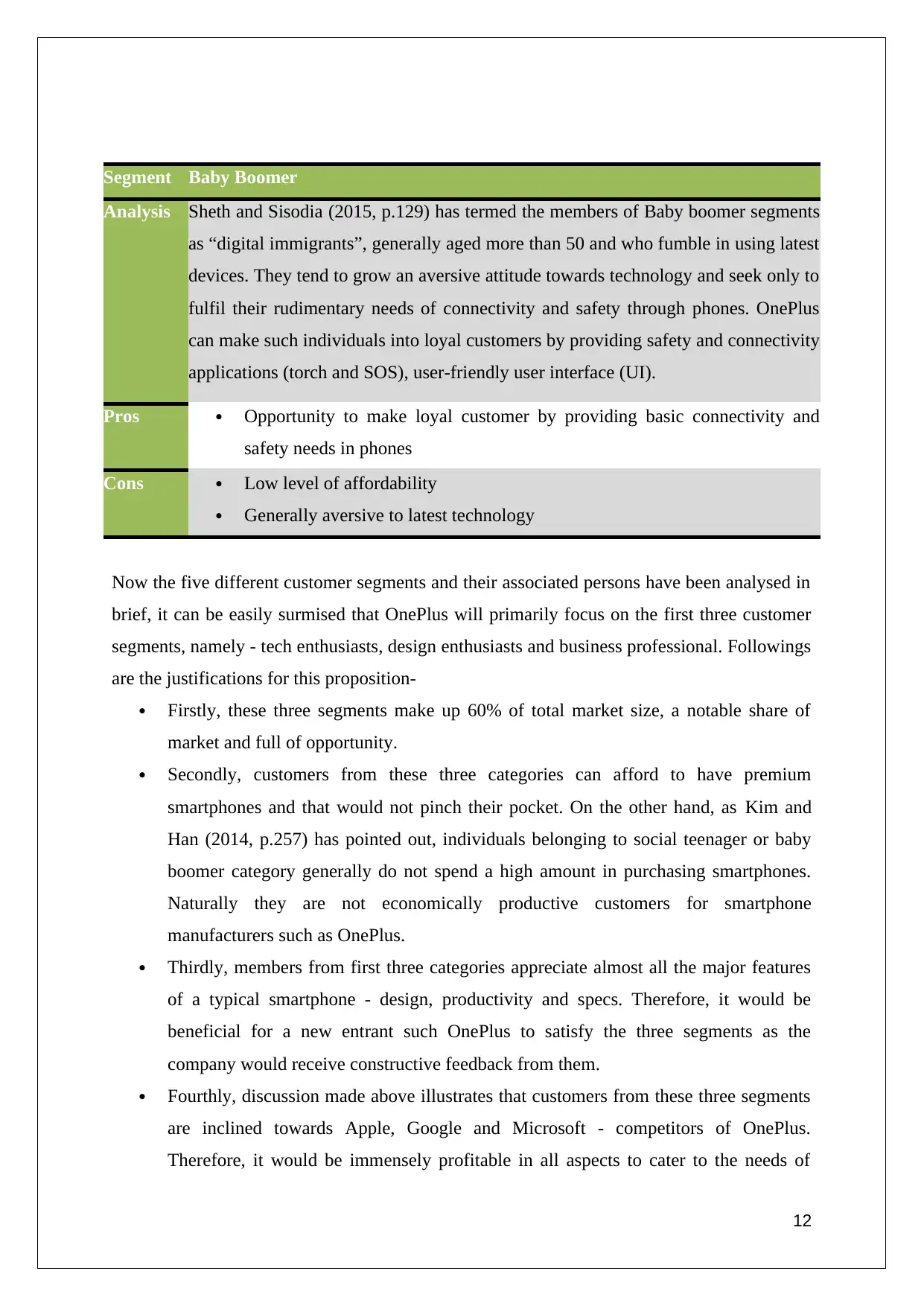
Segment Baby Boomer
Analysis Sheth and Sisodia (2015, p.129) has termed the members of Baby boomer segments
as “digital immigrants”, generally aged more than 50 and who fumble in using latest
devices. They tend to grow an aversive attitude towards technology and seek only to
fulfil their rudimentary needs of connectivity and safety through phones. OnePlus
can make such individuals into loyal customers by providing safety and connectivity
applications (torch and SOS), user-friendly user interface (UI).
Pros Opportunity to make loyal customer by providing basic connectivity and
safety needs in phones
Cons Low level of affordability
Generally aversive to latest technology
Now the five different customer segments and their associated persons have been analysed in
brief, it can be easily surmised that OnePlus will primarily focus on the first three customer
segments, namely - tech enthusiasts, design enthusiasts and business professional. Followings
are the justifications for this proposition-
Firstly, these three segments make up 60% of total market size, a notable share of
market and full of opportunity.
Secondly, customers from these three categories can afford to have premium
smartphones and that would not pinch their pocket. On the other hand, as Kim and
Han (2014, p.257) has pointed out, individuals belonging to social teenager or baby
boomer category generally do not spend a high amount in purchasing smartphones.
Naturally they are not economically productive customers for smartphone
manufacturers such as OnePlus.
Thirdly, members from first three categories appreciate almost all the major features
of a typical smartphone - design, productivity and specs. Therefore, it would be
beneficial for a new entrant such OnePlus to satisfy the three segments as the
company would receive constructive feedback from them.
Fourthly, discussion made above illustrates that customers from these three segments
are inclined towards Apple, Google and Microsoft - competitors of OnePlus.
Therefore, it would be immensely profitable in all aspects to cater to the needs of
12
Analysis Sheth and Sisodia (2015, p.129) has termed the members of Baby boomer segments
as “digital immigrants”, generally aged more than 50 and who fumble in using latest
devices. They tend to grow an aversive attitude towards technology and seek only to
fulfil their rudimentary needs of connectivity and safety through phones. OnePlus
can make such individuals into loyal customers by providing safety and connectivity
applications (torch and SOS), user-friendly user interface (UI).
Pros Opportunity to make loyal customer by providing basic connectivity and
safety needs in phones
Cons Low level of affordability
Generally aversive to latest technology
Now the five different customer segments and their associated persons have been analysed in
brief, it can be easily surmised that OnePlus will primarily focus on the first three customer
segments, namely - tech enthusiasts, design enthusiasts and business professional. Followings
are the justifications for this proposition-
Firstly, these three segments make up 60% of total market size, a notable share of
market and full of opportunity.
Secondly, customers from these three categories can afford to have premium
smartphones and that would not pinch their pocket. On the other hand, as Kim and
Han (2014, p.257) has pointed out, individuals belonging to social teenager or baby
boomer category generally do not spend a high amount in purchasing smartphones.
Naturally they are not economically productive customers for smartphone
manufacturers such as OnePlus.
Thirdly, members from first three categories appreciate almost all the major features
of a typical smartphone - design, productivity and specs. Therefore, it would be
beneficial for a new entrant such OnePlus to satisfy the three segments as the
company would receive constructive feedback from them.
Fourthly, discussion made above illustrates that customers from these three segments
are inclined towards Apple, Google and Microsoft - competitors of OnePlus.
Therefore, it would be immensely profitable in all aspects to cater to the needs of
12
⊘ This is a preview!⊘
Do you want full access?
Subscribe today to unlock all pages.

Trusted by 1+ million students worldwide
1 out of 19
Related Documents
Your All-in-One AI-Powered Toolkit for Academic Success.
+13062052269
info@desklib.com
Available 24*7 on WhatsApp / Email
![[object Object]](/_next/static/media/star-bottom.7253800d.svg)
Unlock your academic potential
Copyright © 2020–2025 A2Z Services. All Rights Reserved. Developed and managed by ZUCOL.





